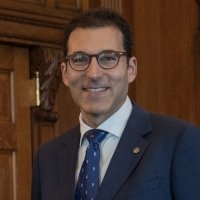
A blog of the Kennan Institute
BY MYKHAILO MINAKOV AND MATTHEW ROJANSKY
In April, Volodymyr Zelenskyy was elected president of Ukraine by a relative landslide (73 percent of Ukrainian voters voted for him). He won with a campaign based on three main promises—promises that reflected the hopes and expectations of Ukraine's deeply frustrated voters: (1) maximum efforts for peace in Donbas, (2) fighting corruption to deliver good and responsive governance, and (3) improving the well-being of ordinary Ukrainian people. In July, Ukrainian voters endorsed this platform again, handing Zelenskyy's Servant of the People party an absolute majority of seats in the Verkhovna Rada, paving the way for the new president to begin delivering on his lofty promises. So, how have the new president and his team met and managed these expectations?
War and Peace
Despite the many obstacles to Donbas conflict resolution, both domestic and external to Ukraine, and notwithstanding some missteps by the new government, President Zelenskyy deserves praise for his commitment to delivering on his biggest campaign promise. Kyiv has restarted negotiations with Moscow, Paris, and Berlin to deescalate and resolve the conflict. The Minsk talks are now much more active and productive than they were in 2017 through early 2019.
A highly visible achievement likely to bear fruit in tamping down heated relations with Russia was the prisoner swap, concluded after several years of waiting. Seventy prisoners—thirty-five held by Ukraine and thirty-five held by the Russia-backed separatists, though fifty-five of the total were in fact Ukrainian citizens—were exchanged in September 2019. Another exchange involving a larger number of detainees is expected soon. This step toward easing the conflict is definitely a tick mark on the success side of the president's ledger.
A second real accomplishment was the start of the front-line withdrawal of troops. Three areas considered appropriate for troop withdrawal had been identified in 2016, but the pullback was initiated only on November 1, 2019, in Stanytsia Luhanska, one of the three sites identified earlier. Signaling the return of normalcy, reconstruction of the destroyed bridge over the Siverskyi Donets river will be finished shortly, reconnecting communities in the area of disengagement. Troops are expected to be withdrawn from two more areas, Petrivske and Zolote, by the end of November 2019. The areas of troop withdrawal were considered to be among the least dangerous on the front line. If effectively implemented, the troop withdrawal could mark the first in a series of steps bringing down the casualty toll among Ukrainian civilians and combatants alike.
However, the situation in the Donbas remains explosive. Despite the ongoing talks in Minsk and force disengagement on the line of contact, more cease-fire violations were committed in both Donetsk and Luhansk oblasts in September than in the previous month. At this point, ending the conflict seems more an aspirational goal than one to be achieved on a timetable.
Russia's illegal annexation of Crimea seems to be excluded from the talks with Russia. Kyiv wants the issue back on the agenda; however, resolution of the conflict in the Donbas takes precedence.
Finally, Zelenskyy's peace plans are meeting growing resistance from pro-Poroshenko groups and nationalist forces. Some radical groups tried to subvert the troop pullback in Stanytsia Luhanska. President Zelenskyy moved on the spot to talk to protesters in the war zone and to resolve the issue. But the entire situation points to the lack of communication between the government, on the one hand, and the military, National Guard, and volunteer paramilitary organizations on the other—and the latter, those with the guns, are proving increasingly persuasive in their resistance to the government's plans to achieve peace.
Corruption and Good Governance
The Ukrainian government has taken some important steps on fighting corruption. Zelenskyy has met frequently with the heads of the anti-corruption institutes, including the Specialized Anti-Corruption Prosecutor's Office, the National Anti-Corruption Bureau (NABU), the National Agency for Prevention of Corruption (NAPC), the State Bureau of Investigations (SBI), the Security Service of Ukraine (SBU), and the Anti-Corruption Court of Ukraine. Each time he has publicly demanded that these agencies prove their efficacy—to the Ukrainian people and to himself.
Most of these bodies have scored only modest achievements. They have arrested some of President Poroshenko's associates and launched investigations into their potential crimes. Among the most visible detainees are Oleg Hladkovsky, a top Defense official and business partner of Poroshenko; a People’s Front party MP and the former head of the Rada's defense committee Serhii Pashinsky; ex-deputy minister for the occupied territories Yuri Hrymchak; and Poroshenko Bloc MP Yaroslav Dubnevych. Other current investigations are focusing on pro-Russia opposition leaders.
However, these arrests and investigations have not yet led to court rulings. And this will not be an easy or a fast process. Moreover, that the investigations were launched almost exclusively against members or associates of the previous President's administration following a power turnover is concerning. Will the anti-corruption bodies be responsive to corrupt behavior in the current governing team, and will it thus confront corruption in real time, not merely waiting to read the political winds following every power shift?
An answer might soon be forthcoming in what happens to Privatbank, whose former owner, oligarch Ihor Kolomoisky, is seen by many as President Zelenskyy’s supporter. Kolomoisky is suing to have the nationalized bank returned to him even as the EBRD and IMF are pushing Zelenskyy to recover the billions in depositors' money that disappeared from Privatbank before the state took over. The IMF, for example, does not believe in the current ruler's independence, having told Zelenskyy he must clean up the financial system and reduce the influence of the oligarchs before a new loan deal can be concluded.
Other achievements in this sector are more positive. The High Anti-Corruption Court, whose launch was delayed by President Poroshenko, has started work; its first ruling came at the end of October 2019. New legislation has lifted Poroshenko-era constraints on the anti-corruption system: the NAPC was reformed to sever ties with the oligarchic clans, while the SBU leadership and other high law-enforcement officials became subject to open reporting requirements in the NAPC e-assets declaration. Also, Zelenskyy’s team has managed to pass a bill that reinstates criminal liability for the illegal enrichment of officials, thus restoring the personal responsibility that was canceled under the previous administration just before Poroshenko left office.
August and September saw a number of cases brought against pro-presidential MPs either for violating the constitution (by voting instead of another MP), or for breaking the moral rules of membership in the legislature, or for receiving cash payments from the Servant of the People faction, Zelenskyy's party. No legal or political action was taken to punish these breaches of trust and the law, however.
Zelenskyy’s fight against corruption has so far taken the form of punishing those adjudged to have engaged in corrupt behaviors. Although his team brings a bit less corruption related baggage than is usual into power in Ukraine, a further test will be how he handles the appearance or reality of corruption among his own allies. Broader good governance and concrete steps to change the longstanding culture of corruption remain as future challenges.
Economic Growth
Ukraine’s economy is now in relatively good shape—a credit first of all to the country's hardworking and innovative population, but also to the work of the previous government with international stewardship and support. During Zelenskyy’s first six months, the country's GDP has continued growing, notching up 3.5 percent growth in the first half of 2019, compared to 3.3 percent for same period in 2018. Also, household consumption has continued to grow.
According to recent data, since September, the hryvnia to dollar exchange rate appreciated by 3.2 percent, to around 24.36 hryvnia per $1 by the end of October, thanks to foreign exchange inflows by nonresidents who are purchasing government securities. Also, though Ukraine's current account deficit had grown by 42 percent from $359 million in August 2018 to $512 million by the beginning of July 2019, this deficit was offset by $639 million in financial inflows.
At the same time, manufacturing and FDI growth remained weak: fixed investment amounts to 20 percent of GDP, which is insufficient for sustainable growth.
There are other holes in the economic picture that may have far-reaching results for Zelenskyy. Small and medium-sized enterprises (SMEs), among Zelenskyy's biggest supporters in the presidential election, are now starting to resist some of the president’s economic initiatives, which are seen as a crackdown on SMEs. In October, for example, a set of new legal acts came into force that increase the tax burden on businesses and increase the power of tax inspectors. The goal of the reform is to eliminate the shadow economy. However, the crackdown should start with the oligarchs, not by putting pressure on small businesses. In response to complaints from SMEs, President Zelenskyy promised a breakthrough for the Ukrainian economy and a two-year period during which SMEs would not be liable to tax inspection.
Meanwhile, Ukraine rose seven points in the World Bank's Doing Business 2020 ranking, reaching the 64th position.
Even though most of the economic developments of 2019, both positive and negative, are not solely the result of Zelenskyy’s team's decisions but are continuations of trends that started under his predecessor, voters do associate them with the young president. It is a reflection of an almost euphoric change of the public mood that Ukrainians have started positively assessing the economic situation in polling data, and they even praise the state of roads, which have long been infamous for their derelict condition, and are in reality hardly different from what they were a year ago.
Trust in the Government
A recent poll conducted by the Sociological Rating Group shows that, despite the various scandals and disappointing decisions, Ukrainians’ optimism prevails, and trust in President Zelenskyy and his government remains high. Moreover, trust in public institutions in general has increased in comparison with the beginning of the year. The most trusted institutions are civilian volunteer organizations (69 percent), veterans of the Donbas war (67 percent), the president (66 percent), and the Ukrainian army (65 percent). The Cabinet of Ministers (45 percent) and the Verkhovna Rada (44 percent) also received very high trust ratings, especially when compared with the 9 percent trust in government measured in December 2018.
The result for Zelenskyy, 66 percent, is high, but seven percentage points lower than in September 2019. This decline should be a wake-up call for the new administration, but it also reflects a more realistic recalibration of Ukrainians' earlier very high expectations. That said, Ukrainians still trust their new president and his team. And it is up to the president to ensure that this trust remains solidly grounded on his achievements.
Authors


President and CEO, US Russia Foundation

Kennan Institute
After more than 50 years as a vital part of the Wilson Center legacy, the Kennan Institute has become an independent think tank. You can find the current website for the Kennan Institute at kennaninstitute.org. Please look for future announcements about partnership activities between the Wilson Center and the Kennan Institute at Wilson Center Press Room. The Kennan Institute is the premier US center for advanced research on Eurasia and the oldest and largest regional program at the Woodrow Wilson International Center for Scholars. The Kennan Institute is committed to improving American understanding of Russia, Ukraine, Central Asia, the South Caucasus, and the surrounding region through research and exchange. Read more

Explore More in Focus Ukraine
Browse Focus Ukraine
Talking to the Dead to Heal the Living

Ukrainian Issue in Polish Elections


